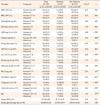1. Zaal IJ, Devlin JW, Peelen LM, Slooter AJ. A systematic review of risk factors for delirium in the ICU. Crit Care Med. 2015; 43(1):40–47. DOI:
10.1097/ccm.0000000000000625.

2. Gusmao-Flores D, Salluh JI, Chalhub RÁ, Quarantini LC. The confusion assessment method for the intensive care unit (CAM-ICU) and intensive care delirium screening checklist (ICDSC) for the diagnosis of delirium: a systematic review and meta-analysis of clinical studies. Crit Care. 2012; 16(4):R115. DOI:
10.1186/cc11407.

3. Arenson BG, MacDonald LA, Grocott HP, Hiebert BM, Arora RC. Effect of intensive care unit environment on in-hospital delirium after cardiac surgery. J Thorac Cardiovasc Surg. 2013; 146(1):172–178. DOI:
10.1016/j.jtcvs.2012.12.042.

4. Moon KY, Lee SM. Development of an evidence-based protocol for preventing delirium in intensive care unit patients. J Korean Clin Nurs Res. 2010; 16(3):175–186.
5. Elie M, Cole MG, Primeau FJ, Bellavance F. Delirium risk factors in elderly hospitalized patients. J Gen Intern Med. 1998; 13(3):204–212. DOI:
10.1046/j.1525-1497.1998.00047.x.

6. Van Rompaey B, Elseviers MM, Schuurmans MJ, Shortridge-Baggett LM, Truijen S, Bossaert L. Risk factors for delirium in intensive care patients: a prospective cohort study. Crit Care. 2009; 13(3):R77. DOI:
10.1186/cc7892.

7. Ely EW, Margolin R, Francis J, May L, Truman B, Dittus R, et al. Evaluation of delirium in critically ill patients: validation of the Confusion Assessment Method for the Intensive Care Unit (CAM-ICU). Crit Care Med. 2001; 29(7):1370–1379.

8. Juliebø V, Bjøro K, Krogseth M, Skovlund E, Ranhoff AH, Wyller TB. Risk factors for preoperative and postoperative delirium in elderly patients with hip fracture. J Am Geriatr Soc. 2009; 57(8):1354–1361. DOI:
10.1111/j.1532-5415.2009.02377.x.
9. Sharma A, Malhotra S, Grover S, Jindal SK. Incidence, prevalence, risk factor and outcome of delirium in intensive care unit: a study from India. Gen Hosp Psychiatry. 2012; 34(6):639–646. DOI:
10.1016/j.genhosppsych.2012.06.009.

10. McManus J, Pathansali R, Hassan H, Ouldred E, Cooper D, Stewart R, et al. The course of delirium in acute stroke. Age Ageing. 2009; 38(4):385–389. DOI:
10.1093/ageing/afp038.

11. Ouimet S, Kavanagh BP, Gottfried SB, Skrobik Y. Incidence, risk factors and consequences of ICU delirium. Intensive Care Med. 2007; 33(1):66–73. DOI:
10.1007/s00134-006-0399-8.

12. Haymore JB, Patel N. Delirium in the neuro intensive care unit. Crit Care Nurs Clin North Am. 2016; 28(1):21–35. DOI:
10.1016/j.cnc.2015.11.001.

13. Caeiro L, Menger C, Ferro JM, Albuquerque R, Figueira ML. Delirium in acute subarachnoid haemorrhage. Cerebrovasc Dis. 2005; 19(1):31–38. DOI:
10.1159/000081909.

14. Carin-Levy G, Mead GE, Nicol K, Rush R, van Wijck F. Delirium in acute stroke: screening tools, incidence rates and predictors: a systematic review. J Neurol. 2012; 259(8):1590–1599. DOI:
10.1007/s00415-011-6383-4.

15. Mitasova A, Kostalova M, Bednarik J, Michalcakova R, Kasparek T, Balabanova P, et al. Poststroke delirium incidence and outcomes: validation of the Confusion Assessment Method for the Intensive Care Unit (CAM-ICU). Crit Care Med. 2012; 40(2):484–490. DOI:
10.1097/CCM.0b013e318232da12.
16. Oldenbeuving AW, de Kort PL, Jansen BP, Algra A, Kappelle LJ, Roks G. Delirium in the acute phase after stroke Incidence, risk factors, and outcome. Neurology. 2011; 76(11):993–999. DOI:
10.1212/WNL.0b013e318210411f.

17. Sheng AZ, Shen Q, Cordato D, Zhang YY, Yin Chan DK. Delirium within three days of stroke in a cohort of elderly patients. J Am Geriatr Soc. 2006; 54(8):1192–1198. DOI:
10.1111/j.1532-5415.2006.00806.x.

18. Ferro JM, Caeiro L, Verdelho A. Delirium in acute stroke. Curr Opin Neurol. 2002; 15(1):51–55.

19. Heo EY, Lee BJ, Hahm BJ, Song EH, Lee HA, Yoo CG, et al. Translation and validation of the Korean confusion assessment method for the intensive care unit. BMC Psychiatry. 2011; 11(1):94. DOI:
10.1186/1471-244x-11-94.

20. Teasdale G, Jennett B. Assessment of coma and impaired consciousness: a practical scale. Lancet. 1974; 2(7872):81–84. DOI:
10.1016/S0140-6736(74)91639-0.
21. Knaus WA, Zimmerman JE, Wagner DP, Draper EA, Lawrence DE. APACHE-acute physiology and chronic health evaluation: a physiologically based classification system. Crit Care Med. 1981; 9(8):591–597.

23. Sendelbach S, Guthrie PF. Acute Confusion/Delirium: identification, assessment, treatment, and prevention. J Gerontol Nurs. 2009; 35(11):11–18. DOI:
10.3928/00989134-20090930-01.

24. Barr J, Fraser GL, Puntillo K, Ely EW, Gélinas C, Dasta JF, et al. Clinical practice guidelines for the management of pain, agitation, and delirium in adult patients in the intensive care unit. Crit Care Med. 2013; 41(1):263–306. DOI:
10.1097/CCM.0b013e3182783b72.

25. Khan AY, Kalimuddin MN, Gorman JM. Neuropsychiatric manifestations of phenytoin toxicity in an elderly patient. J Psychiatr Pract. 2007; 13(1):49–54.

26. American Psychiatric Association. Diagnostic and statistical manual of mental disorders (DSM-IV-TR). 4th ed. Washington DC: American Psychiatric Association;2000.
27. Spronk PE, Riekerk B, Hofhuis J, Rommes JH. Occurrence of delirium is severely underestimated in the ICU during daily care. Intensive Care Med. 2009; 35(7):1276–1280. DOI:
10.1007/s00134-009-1466-8.

28. Aldemir M, Özen S, Kara IH, Sir A, Baç B. Predisposing factors for delirium in the surgical intensive care unit. Crit Care. 2001; 5(5):265–270. DOI:
10.1186/cc1044.
29. Kagansky N, Rimon E, Naor S, Dvornikov E, Cojocaru L, Levy S. Low incidence of delirium in very old patients after surgery for hip fractures. Am J Geriatr Psychiatry. 2004; 12(3):306–314. DOI:
10.1097/00019442-200405000-00010.

30. Gélinas C, Fillion L, Puntillo KA, Viens C, Fortier M. Validation of the critical-care pain observation tool in adult patients. Am J Crit Care. 2006; 15(4):420–427.







 PDF
PDF ePub
ePub Citation
Citation Print
Print





 XML Download
XML Download